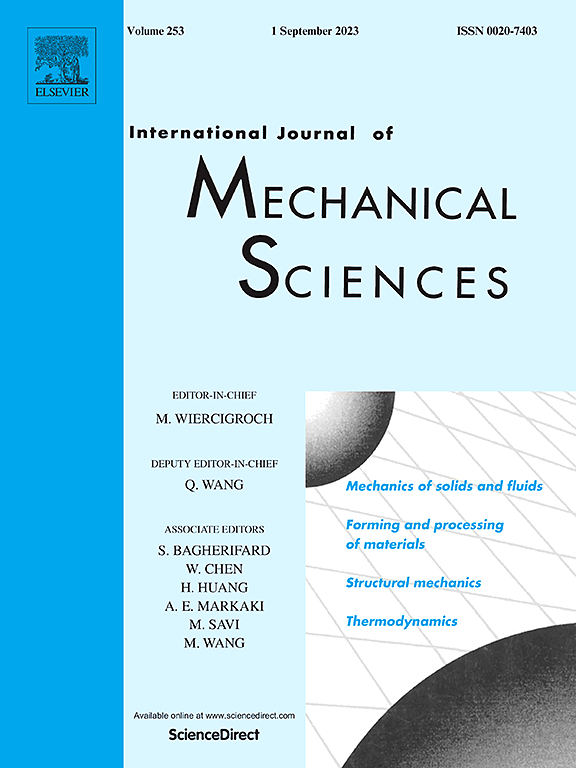Large deformation of a punctured disc with the target morphology
IF 7.1
1区 工程技术
Q1 ENGINEERING, MECHANICAL
International Journal of Mechanical Sciences
Pub Date : 2025-06-23
DOI:10.1016/j.ijmecsci.2025.110527
引用次数: 0
Abstract
Thin sheets widely exist in nature. Studying their fascinating morphologies in three-dimensional space is not only a fundamental scientific issue but of significant practical applications. Utilizing differential manifolds based on the Riemannian metric, this paper addresses the large deformation of a sheet. First, with the polar coordinates, the two-dimensional manifold of a punctured disc and the metric tensor induced by a temperature field are described, providing a geometric interpretation of the thermal deformation mechanism. Next, the equilibrium equations and the boundary conditions for the large deformation of a target cone are derived. Finally, given the temperature field, the deformation and the residual stress are solved. The temperature distribution is also obtained for the stress-free target cone. The results indicate that both the temperature field and the target morphology significantly impact the deformation and the residual stress. This work is a straightforward extension of the customary in-plane thermal deformation theory to the two-dimensional manifold in the three-dimensional Euclidean space, and hence provides the fundamental theory and the solution technique for the finer design of thin sheets.

大变形的穿孔椎间盘与目标形态
薄板在自然界中广泛存在。研究它们在三维空间中迷人的形态不仅是一个基本的科学问题,而且具有重要的实际应用价值。利用基于黎曼度量的微分流形,研究了薄板的大变形问题。首先,利用极坐标,描述了穿孔盘的二维流形和温度场诱导的度量张量,提供了热变形机制的几何解释。其次,导出了目标锥体大变形时的平衡方程和边界条件。最后,在给定温度场的情况下,求解了变形和残余应力。得到了无应力靶锥的温度分布。结果表明,温度场和目标形貌对变形和残余应力均有显著影响。本工作是将平面内热变形理论直接推广到三维欧几里得空间的二维流形,从而为薄板的精细设计提供了基础理论和求解技术。
本文章由计算机程序翻译,如有差异,请以英文原文为准。
求助全文
约1分钟内获得全文
求助全文
来源期刊

International Journal of Mechanical Sciences
工程技术-工程:机械
CiteScore
12.80
自引率
17.80%
发文量
769
审稿时长
19 days
期刊介绍:
The International Journal of Mechanical Sciences (IJMS) serves as a global platform for the publication and dissemination of original research that contributes to a deeper scientific understanding of the fundamental disciplines within mechanical, civil, and material engineering.
The primary focus of IJMS is to showcase innovative and ground-breaking work that utilizes analytical and computational modeling techniques, such as Finite Element Method (FEM), Boundary Element Method (BEM), and mesh-free methods, among others. These modeling methods are applied to diverse fields including rigid-body mechanics (e.g., dynamics, vibration, stability), structural mechanics, metal forming, advanced materials (e.g., metals, composites, cellular, smart) behavior and applications, impact mechanics, strain localization, and other nonlinear effects (e.g., large deflections, plasticity, fracture).
Additionally, IJMS covers the realms of fluid mechanics (both external and internal flows), tribology, thermodynamics, and materials processing. These subjects collectively form the core of the journal's content.
In summary, IJMS provides a prestigious platform for researchers to present their original contributions, shedding light on analytical and computational modeling methods in various areas of mechanical engineering, as well as exploring the behavior and application of advanced materials, fluid mechanics, thermodynamics, and materials processing.
 求助内容:
求助内容: 应助结果提醒方式:
应助结果提醒方式:


